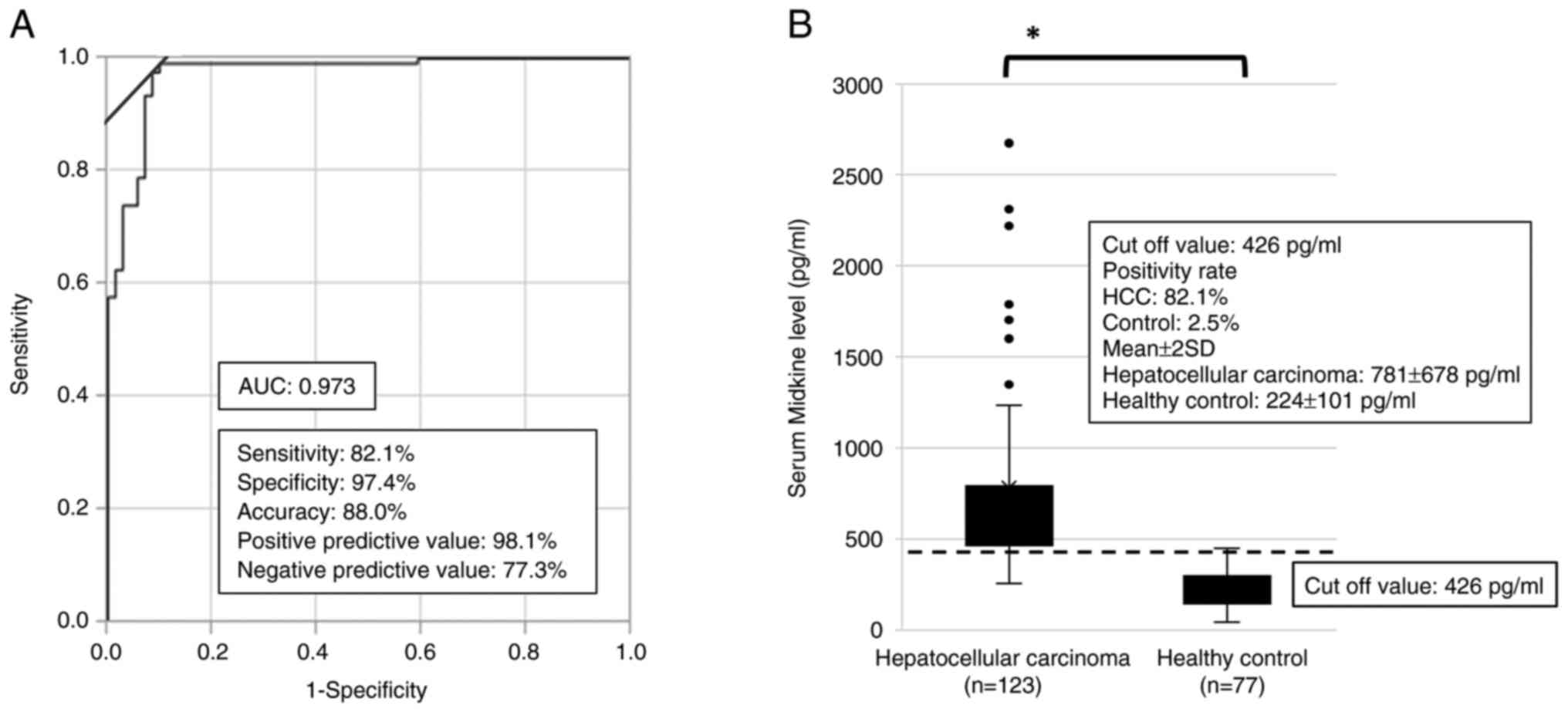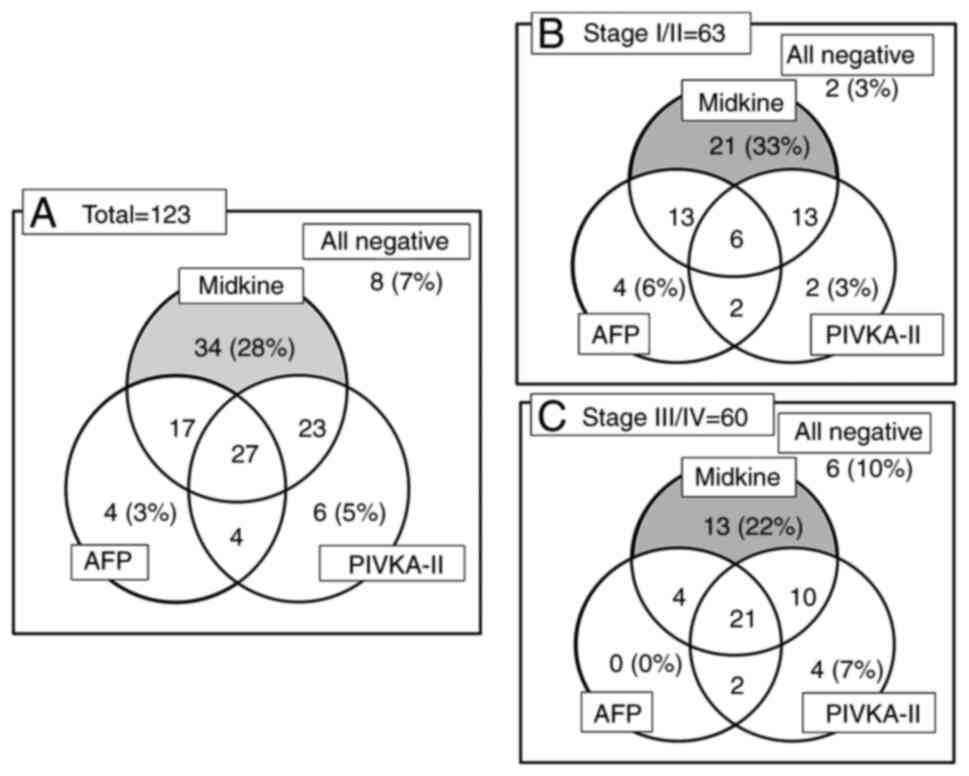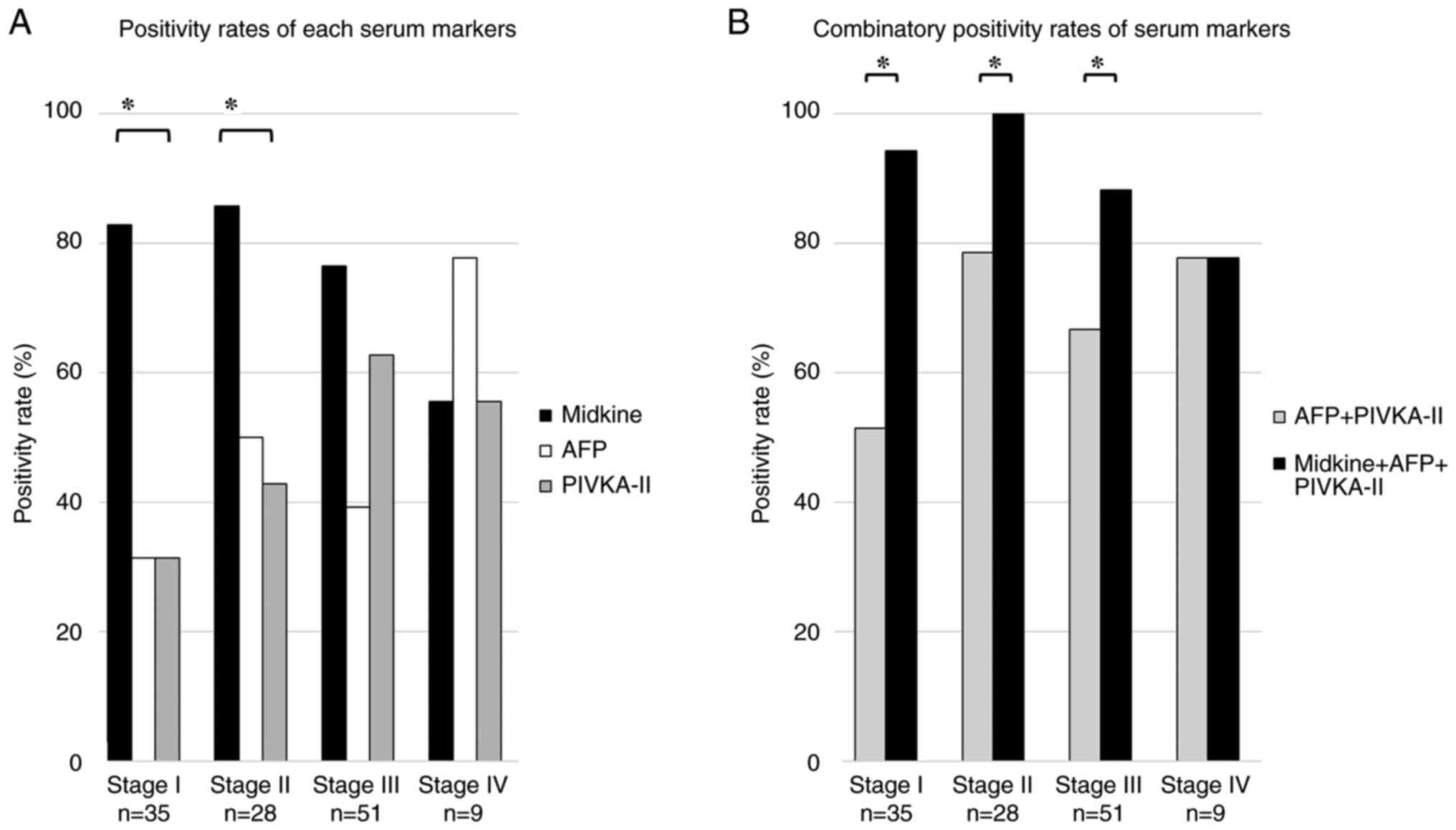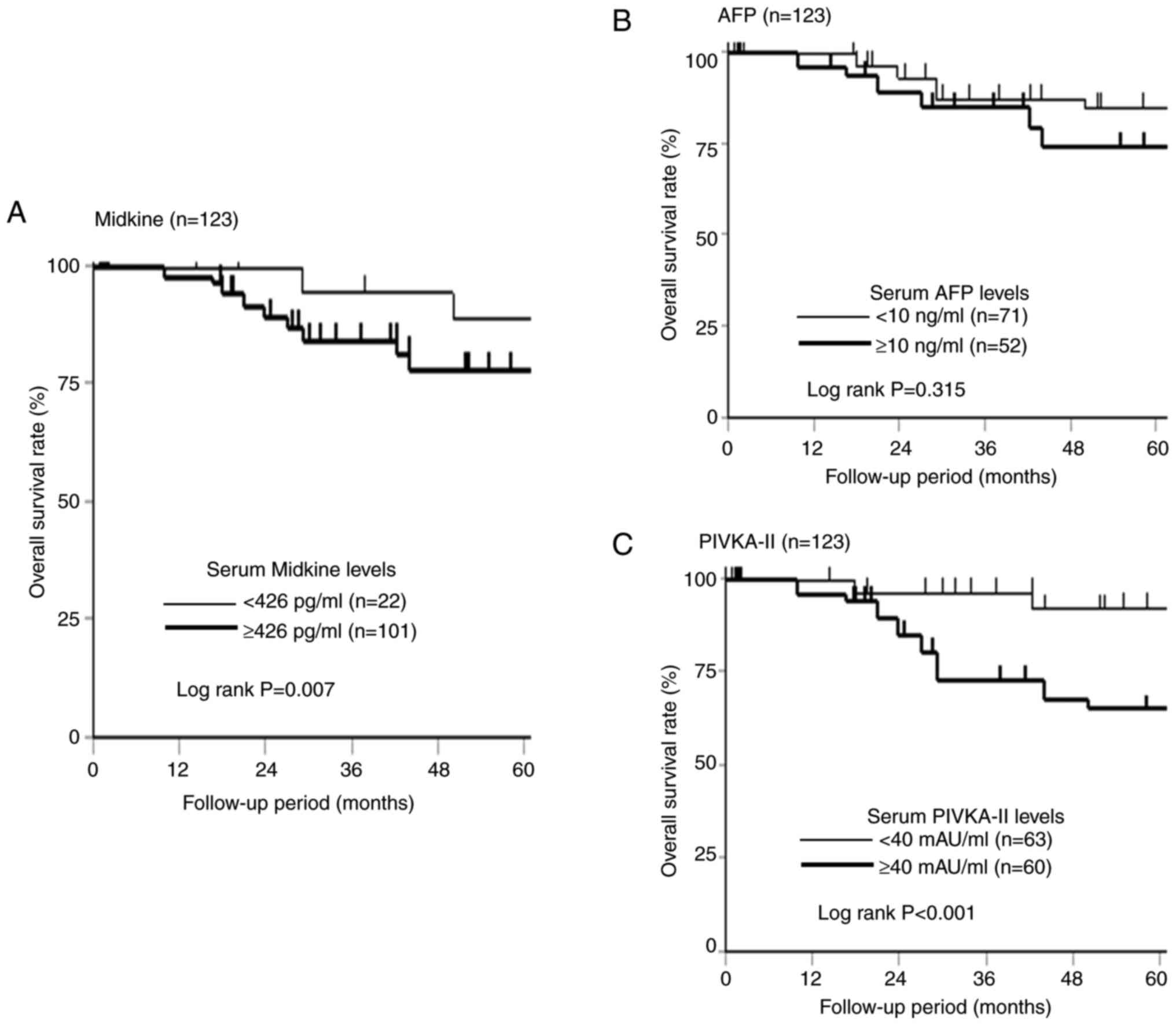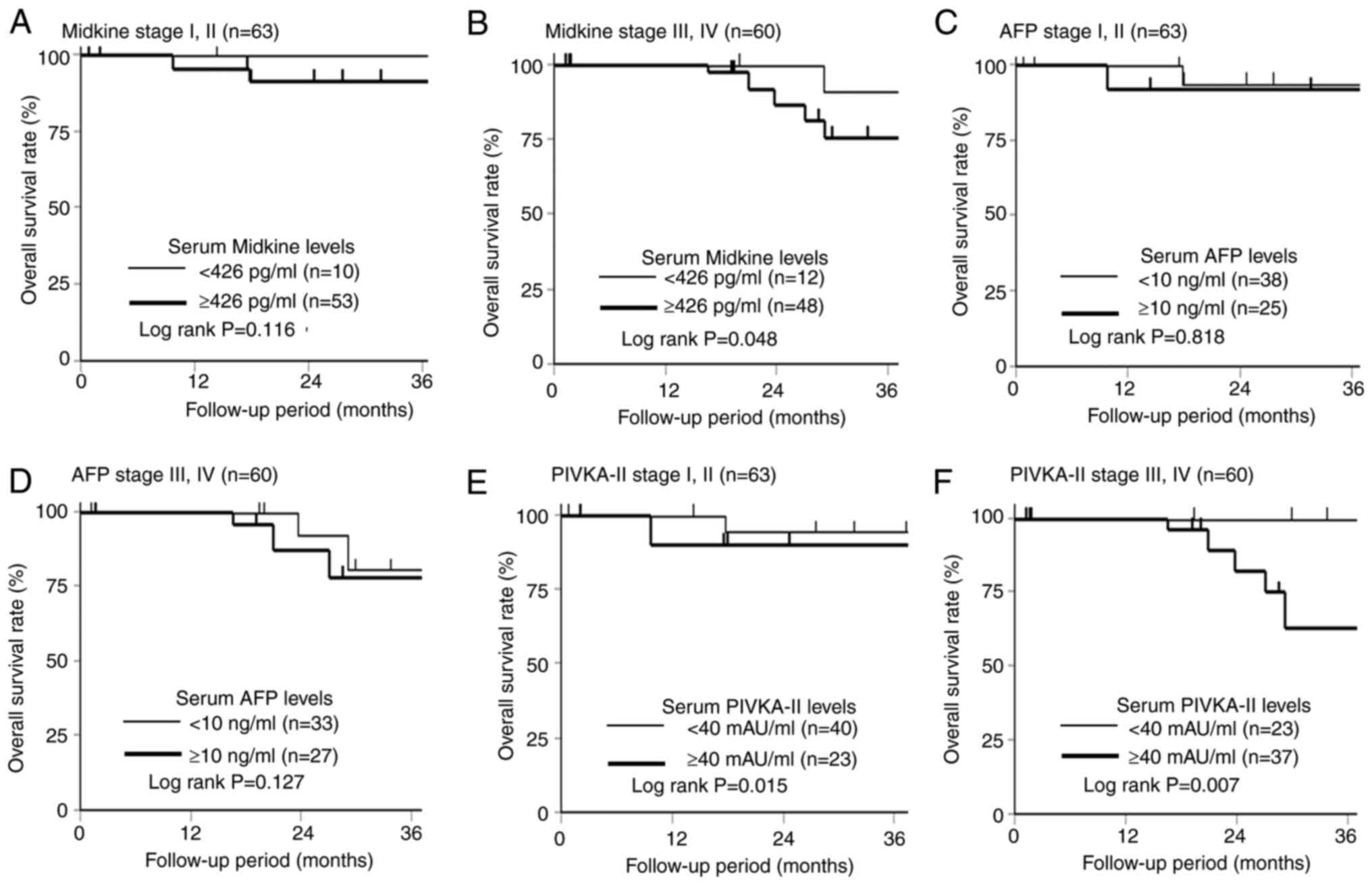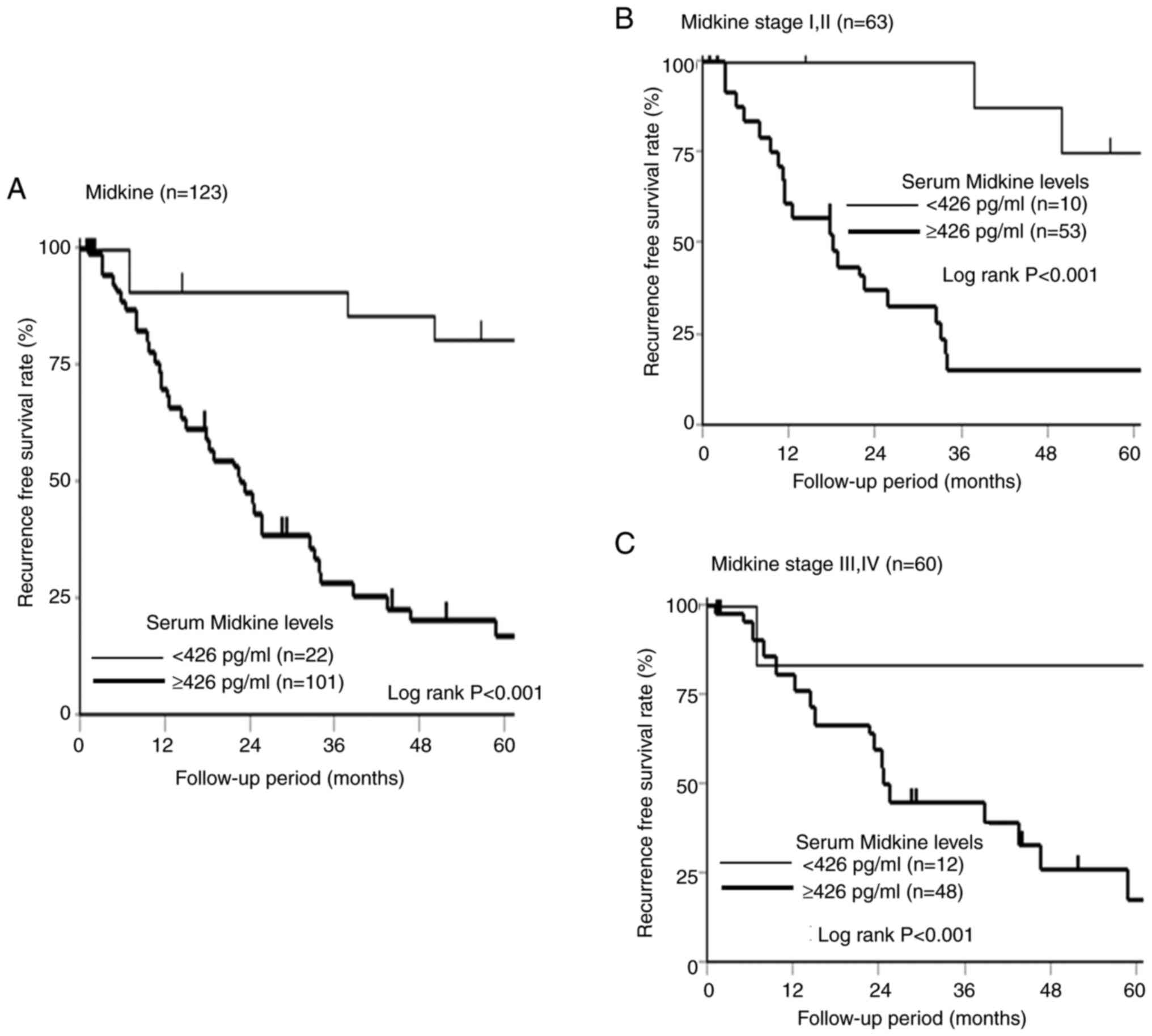|
1
|
Kadomatsu K: Midkine, a heparin-binding
growth factor: Its discovery and functions. Seikagaku.
70:1315–1325. 1998.(In Japanese). PubMed/NCBI
|
|
2
|
Muramatsu T: Midkine, a heparin-binding
cytokine with multiple roles in development, repair and diseases.
Proc Jpn Acad Ser B Phys Biol Sci. 86:410–425. 2010. View Article : Google Scholar : PubMed/NCBI
|
|
3
|
Jones DR: Measuring midkine: The utility
of midkine as a biomarker in cancer and other diseases. Br J
Pharmacol. 171:2925–2939. 2014. View Article : Google Scholar : PubMed/NCBI
|
|
4
|
Tsuchiya N, Sawada Y, Endo I, Saito K,
Uemura Y and Nakatsura T: Biomarkers for the early diagnosis of
hepatocellular carcinoma. World J Gastroenterol. 21:10573–10583.
2015. View Article : Google Scholar : PubMed/NCBI
|
|
5
|
Okada R, Otsuka Y, Wakabayashi T, Shinoda
M, Aoki T, Murakami M, Arizumi S, Yamamoto M, Aramaki O, Takayama
T, et al: Six autoantibodies as potential serum biomarkers of
hepatocellular carcinoma: A prospective multicenter study. Int J
Cancer. 147:2578–2586. 2020. View Article : Google Scholar : PubMed/NCBI
|
|
6
|
Okada R, Otsuka Y, Yokosuka O, Kato N,
Imazaki F, Hoshino I, Sugiura N, Mizumoto H, Azemoto R, Kato K and
Shimada H: Six autoantibodies as potential differential biomarkers
of hepatocellular carcinoma vs. liver cirrhosis and chronic
hepatitis: A prospective multi-institutional study. Oncol Lett.
24:3672022. View Article : Google Scholar : PubMed/NCBI
|
|
7
|
Kadomatsu K and Muramatsu T: Midkine and
pleiotrophin in neural development and cancer. Cancer Lett.
204:127–143. 2004. View Article : Google Scholar : PubMed/NCBI
|
|
8
|
Mashaly AH, Anwar R, Ebrahim MA, Eissa LA
and El Shishtawy MM: Diagnostic and prognostic value of talin-1 and
midkine as tumor markers in hepatocellular carcinoma in Egyptian
patients. Asian Pac J Cancer Prev. 19:1503–1508. 2018.PubMed/NCBI
|
|
9
|
Hodeib H, ELshora O, Selim A, Sabry NM and
El-Ashry HM: Serum midkine and osteopontin levels as diagnostic
biomarkers of hepatocellular carcinoma. Electron Physician.
9:3492–3498. 2017. View
Article : Google Scholar : PubMed/NCBI
|
|
10
|
Vongsuvanh R, van der Poorten D, Iseli T,
Strasser SI, McCaughan GW and George J: Midkine increases
diagnostic yield in AFP negative and NASH-related hepatocellular
carcinoma. PLoS One. 11:e01558002016. View Article : Google Scholar : PubMed/NCBI
|
|
11
|
Zhang BH, Li B, Kong LX, Yan LN and Yang
JY: Diagnostic accuracy of midkine on hepatocellular carcinoma: A
meta-analysis. PLoS One. 14:e02235142019. View Article : Google Scholar : PubMed/NCBI
|
|
12
|
Lu Q, Li J, Cao H, Lv C, Wang X and Cao S:
Comparison of diagnostic accuracy of midkine and AFP for detecting
hepatocellular carcinoma: A systematic review and meta-analysis.
Biosci Rep. 40:BSR201924242020. View Article : Google Scholar : PubMed/NCBI
|
|
13
|
Kemper M, Hentschel W, Graß JK, Stüben BO,
Konczalla L, Rawnaq T, Ghadban T, Izbicki JR and Reeh M: Serum
midkine is a clinical significant biomarker for colorectal cancer
and associated with poor survival. Cancer Med. 9:2010–2018. 2020.
View Article : Google Scholar : PubMed/NCBI
|
|
14
|
Stern L, Mueller E, Bellon E, Reeh M,
Grotelueschen R, Guengoer C, Melling N, Goetz M, Perez DR, Izbicki
JR, et al: Serum midkine as non-invasive biomarker for detection
and prognosis of non-small cell lung cancer. Sci Rep. 11:146162021.
View Article : Google Scholar : PubMed/NCBI
|
|
15
|
Shiratori F, Ito M, Yajima S, Suzuki T,
Oshima Y, Nanami T, Funahashi K and Shimada H: The effectiveness of
serum midkine in detecting esophageal squamous cell carcinoma.
Esophagus. 16:246–251. 2019. View Article : Google Scholar : PubMed/NCBI
|
|
16
|
Ito M, Oshima Y, Yajima S, Suzuki T,
Nanami T, Shiratori F, Funahashi K and Shimada H: Diagnostic impact
of high serum midkine level in patients with gastric cancer. Ann
Gastroenterol Surg. 3:195–201. 2019. View Article : Google Scholar : PubMed/NCBI
|
|
17
|
Union for International Cancer Control, .
TNM Classification of Malignant Tumors. Brierley JD, Gospodarowicz
MK and Wittekind CH: 8th edition. UICC; Wiley, New York, NY:
2001
|
|
18
|
Makuuchi M and Kokudo N: Clinical practice
guidelines for hepatocellular carcinoma: The first evidence based
guidelines from Japan. World J Gastroenterol. 12:828–829. 2006.
View Article : Google Scholar : PubMed/NCBI
|
|
19
|
Kubota K, Makuuchi M, Kusaka K, Kobayashi
T, Miki K, Hasegawa K, Harihara Y and Takayama T: Measurement of
liver volume and hepatic functional reserve as a guide to
decision-making in resectional surgery for hepatic tumors.
Hepatology. 26:1176–1181. 1997. View Article : Google Scholar : PubMed/NCBI
|
|
20
|
Kudo M, Izumi N, Kokudo N, Matsui O,
Sakamoto M, Nakashima O, Kojiro M and Makuuchi M; HCC Expert Panel
of Japan Society of Hepatology, : Management of hepatocellular
carcinoma in Japan: Consensus-Based Clinical Practice Guidelines
proposed by the Japan Society of Hepatology (JSH) 2010 updated
version. Dig Dis. 29:339–364. 2011. View Article : Google Scholar : PubMed/NCBI
|
|
21
|
Ketenci S, Uygar Kalaycı M, Dündar B,
Duranay R and Şükrü Aynacıoğlu A: Elevated serum midkine levels in
severe acute respiratory syndrome coronavirus 2 (SARS-CoV-2)
infected patients. Int Immunopharmacol. 110:1089392022. View Article : Google Scholar : PubMed/NCBI
|
|
22
|
Shaheen KY, Abdel-Mageed AI, Safwat E and
AlBreedy AM: The value of serum midkine level in diagnosis of
hepatocellular carcinoma. Int J Hepatol. 2015:1463892015.
View Article : Google Scholar : PubMed/NCBI
|
|
23
|
Shin DH, Jo JY, Kim SH, Choi M, Han C,
Choi BK and Kim SS: Midkine is a potential therapeutic target of
tumorigenesis, angiogenesis, and metastasis in non-small cell lung
cancer. Cancers (Basel). 12:24022020. View Article : Google Scholar : PubMed/NCBI
|
|
24
|
Karadeniz Z, Aynacıoğlu AŞ, Bilir A and
Tuna MY: Inhibition of midkine by metformin can contribute to its
anticancer effects in malignancies: A proposal mechanism of action
of metformin in context of endometrial cancer prevention and
therapy. Med Hypotheses. 134:1094202020. View Article : Google Scholar : PubMed/NCBI
|
|
25
|
Qi M, Ikematsu S, Ichihara-Tanaka K,
Sakuma S, Muramatsu T and Kadomatsu K: Midkine rescues Wilms' tumor
cells from cisplatin-induced apoptosis: Regulation of Bcl-2
expression by midkine. J Biochem. 127:269–277. 2000. View Article : Google Scholar : PubMed/NCBI
|
|
26
|
Sasaki R, Kanda T, Yokosuka O, Kato N,
Matsuoka S and Moriyama M: Exosomes and hepatocellular carcinoma:
From bench to bedside. Int J Mol Sci. 20:14062019. View Article : Google Scholar : PubMed/NCBI
|
|
27
|
Qin S, Chen M, Cheng AL, Kaseb AO, Kudo M,
Lee HC, Yopp AC, Zhou J, Wang L, Wen X, et al: Atezolizumab plus
bevacizumab versus active surveillance in patients with resected or
ablated high-risk hepatocellular carcinoma (IMbrave050): A
randomised, open-label, multicentre, phase 3 trial. Lancet.
402:1835–1847. 2023. View Article : Google Scholar : PubMed/NCBI
|
|
28
|
Yamashita T, Shimada H, Tanaka S, Araki K,
Tomifuji M, Mizokami D, Tanaka N, Kamide D, Miyagawa Y, Suzuki H,
et al: Serum midkine as a biomarker for malignancy, prognosis, and
chemosensitivity in head and neck squamous cell carcinoma. Cancer
Med. 5:415–425. 2016. View
Article : Google Scholar : PubMed/NCBI
|
|
29
|
Shimada H, Nabeya Y, Tagawa M, Okazumi S,
Matsubara H, Kadomatsu K, Muramatsu T, Ikematsu S, Sakuma S and
Ochiai T: Preoperative serum midkine concentration is a prognostic
marker for esophageal squamous cell carcinoma. Cancer Sci.
94:628–632. 2003. View Article : Google Scholar : PubMed/NCBI
|
|
30
|
Alzamzamy A, Elsayed H, Abd Elraouf M,
Eltoukhy H, Megahed T and Aboubakr A: Serum vascular endothelial
growth factor as a tumor marker for hepatocellular carcinoma in
hepatitis C virus-related cirrhotic patients. World J Gastrointest
Oncol. 13:600–611. 2021. View Article : Google Scholar : PubMed/NCBI
|
|
31
|
Mamdouh S, Soliman A, Khorshed F and Saber
M: Glypican-3, vascular endothelial growth factor and golgi
protein-73 for differentiation between liver cirrhosis and
hepatocellular carcinoma. Asian Pac J Cancer Prev. 24:497–507.
2023. View Article : Google Scholar : PubMed/NCBI
|



